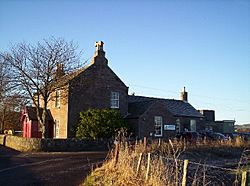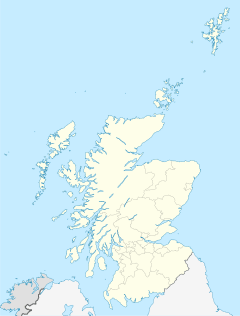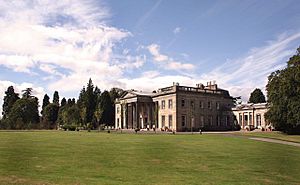Stracathro facts for kids
Quick facts for kids Stracathro
|
|
|---|---|
 Stracathro School |
|
| Council area | |
| Lieutenancy area | |
| Country | Scotland |
| Sovereign state | United Kingdom |
| Post town | BRECHIN |
| Postcode district | DD9 |
| Dialling code | 01356 |
| Ambulance | Scottish |
| EU Parliament | Scotland |
| UK Parliament |
|
| Scottish Parliament | |
Stracathro (which is Srath Catharach in Scottish Gaelic) is a small village in Angus, Scotland. It was once the site of a Roman marching camp when Roman soldiers moved north.
Contents
Where is Stracathro Located?
Stracathro is about 4 kilometers (2.5 miles) southeast of Edzell. It is in the northeast part of Angus. The village is also northeast of Brechin, right by the A90 highway.
A Look at Stracathro's History
A Roman marching camp was found at Stracathro. This camp was one day's march from the next Roman camp, which was at Raedykes further north. The gates of the Stracathro Roman Camp had a special bell-shaped design.
The Battle of Stracathro
Stracathro was the site of the Battle of Stracathro in 1130. This battle happened because Angus, a ruler from the area of Moray, wanted to expand his land. He also wanted to be seen as independent from the Scottish kings.
The royal army of Scotland met Angus's forces. The king, King David, was busy in England. So, the army was led by the Constable of Scotland, a high-ranking officer. The king's army won a big victory. About four thousand of Angus's men were killed, including Angus himself. After this, Moray became a full part of the Kingdom of Scotland.
John Balliol and Scottish Independence
On July 7, 1296, something very important happened in Stracathro. John Balliol, who was the King of Scotland, publicly agreed to the demands of Edward I, King of England. John Balliol gave up his crown on July 10. The symbols of Scotland were taken from his coat. He was then held in the Tower of London for three years.
After that, he was allowed to go to France, where he died in 1314. His decision to give up the Scottish crown and royal seal to Edward I of England led to the start of the First War of Scottish Independence. This was a long fight for Scotland to be free from English rule.
Stracathro in Recent Times
A railway line was built in the late 1800s. This connected Stracathro to other villages. The train station here was first called Inchbare. Then it was briefly named Dunlappie. Finally, it became Stracathro. From 1896 to 1964, Stracathro railway station served the local area. This included Stracathro, Inchbare, and other nearby places.
Stracathro House
Stracathro House is a very old and grand house. It is built in a style called Palladian, which is a type of classical architecture. The house looks out over the Cruick Water. In 1775, a man named Patrick Cruickshank bought the Stracathro Estate. This estate was very large, almost 800 hectares (about 2,000 acres). Patrick had earned his money from sugar farms in Jamaica, where people were forced to work.
His brother, Alexander, later inherited the property. He hired an architect named Archibald Simpson to build the house. This happened between 1824 and 1827. They also created a deer park and gardens. In 1874, Sir James Campbell bought the house and estate. He was a very important person in Glasgow and was the father of Prime Minister Sir Henry Campbell-Bannerman.
The government took over Stracathro House in 1938. It was used for a while. But in 2003, it was sold back to private owners. Now, it is being fixed up to be a family home. Some small houses on the grounds are rented out for holidays.
Stracathro Hospital
During the Second World War, a temporary hospital was set up at Stracathro House. This hospital helped both soldiers and civilians who were hurt. After the war, Stracathro Hospital became a regular NHS hospital. It is now managed by NHS Tayside.
See also
 In Spanish: Stracathro para niños
In Spanish: Stracathro para niños



